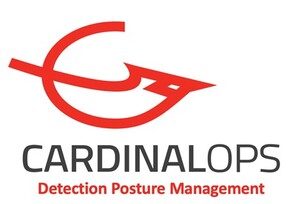CardinalOps' data-driven report analyzes thousands of detection rules from production SIEM instances to reveal how prepared we are to defend against the latest threats
TEL AVIV, Israel and BOSTON, May 18, 2022 /PRNewswire/ -- CardinalOps, the AI-powered detection engineering company, today released its 2022 Report on the State of SIEM Detection Risk. The company's second annual report analyzed aggregated and anonymized data from production SIEM instances to understand SOC preparedness to detect the latest adversary techniques in MITRE ATT&CK, the industry-standard catalog of common adversary behaviors based on real-world observations. This is important because detecting malicious activity early in the intrusion lifecycle is a key factor in preventing material impact to the organization.
The analysis shows that actual detection coverage remains far below what most organizations expect, and that many organizations are unaware of the gap between their assumed theoretical security and the defenses they actually have in place.
The data set for this analysis spanned diverse SIEM solutions – including Splunk, Microsoft Sentinel, and IBM QRadar – encompassing more than 14,000 log sources, thousands of detection rules, and hundreds of log source types, spanning diverse industry verticals including financial services, manufacturing, telecommunications, and MSSP/MDR service providers. Using MITRE ATT&CK as the baseline, CardinalOps found that, on average:
- Enterprise SIEMs contain detections for fewer than 5 of the top 14 ATT&CK techniques employed by adversaries in the wild1
- SIEMs are missing detections for 80% of the complete list of 190+ ATT&CK techniques
- 15% of SIEM rules are broken and will never fire, primarily due to fields that are not extracted correctly or log sources that are not sending the required data
- Only 25% of organizations that forward identity logs such as Active Directory and Okta to their SIEM, actually use them in their detection rules – which is concerning because identity monitoring is one of the most critical data sources for strengthening zero trust
- 75% of generic out-of-the-box detection content provided by SIEM vendors is disabled due to noisiness and customization challenges experienced by detection engineering teams
These major gaps in detection coverage can be attributed to a number of challenges faced by SOCs and detection engineering teams. At the top of the list is constant change in the threat landscape, organizational attack surfaces, and business priorities, combined with an exponential increase in configuration complexity resulting from an ever-increasing number of log source types and telemetry from diverse data sources (endpoint, identity, cloud, etc.). Difficulty in recruiting and retaining skilled security personnel is also a major factor. And many enterprises are still relying on manual and error-prone processes for developing new detections, which makes it difficult for engineering teams to scale effectively and reduce their backlogs.
"Organizations need to become more intentional about detection in their SOCs. What should we detect? Do we have use cases for those scenarios? Do they actually work? Do they help my SOC analysts effectively triage and respond?" said Dr. Anton Chuvakin, Head of Security Solution Strategy, Google Cloud. "Detection use cases are the core of security monitoring activities. Having structured and repeatable processes is essential for prioritization, aligning monitoring efforts to security strategy, and maximizing the value obtained from your security monitoring tools."
To help organizations address their detection challenges, the 2022 CardinalOps report includes a series of best practices to help SOC teams measure and increase the robustness of their detection coverage, so they can continuously improve their detection posture over time.
"Our goal with creating this report was not to shame security teams for having blind spots, but rather to draw management-level attention to the disparity between perceived security and actual detection quality and coverage, using MITRE ATT&CK as the benchmark," said Michael Mumcuoglu, CEO and co-founder at CardinalOps. "If we're spending all this time and money on more security tools, why are we still being hacked? We believe the answer lies in the need to apply automation and analytics to identify and fix misconfigurations in existing tools, and remediate the riskiest detection gaps, in order to free detection engineers to focus on more strategic activities such as investigating new and novel attack scenarios."
You can download the full report here.
About CardinalOps
CardinalOps' cloud-based platform continuously ensures your SIEM/XDR has high-fidelity detections for the adversary techniques most relevant to your business priorities and infrastructure, as measured by the MITRE ATT&CK framework.
Leveraging AI-powered analytics and API-driven automation, the platform continuously delivers customized detection content and metrics enabling your SOC team to stay ahead of constant change in the attack surface and threat landscape – plus continuously identify and remediate misconfigured data sources and broken or noisy rules – so you can eliminate the highest risk MITRE ATT&CK gaps that leave your organization exposed.
Founded in early 2020, CardinalOps is led by serial entrepreneurs whose previous companies were acquired by Palo Alto Networks, HP, Microsoft Security, IBM Security, and others. The company's advisory board includes Dr. Anton Chuvakin, recognized SIEM expert and Head of Security Solution Strategy at Google; Dan Burns, former Optiv CEO and founder of Accuvant; and Randy Watkins, CTO of Critical Start. For more information, please visit https://www.cardinalops.com/.
1 In our analysis, we chose to exclude two ATT&CK techniques that SIEMs are ill-equipped to address: Process Injection and Credential Dumping. |
For Media Inquiries:
Nathaniel Hawthorne for CardinalOps
Lumina Communications
(661) 965-0407
[email protected]
SOURCE CardinalOps

WANT YOUR COMPANY'S NEWS FEATURED ON PRNEWSWIRE.COM?
Newsrooms &
Influencers
Digital Media
Outlets
Journalists
Opted In





Share this article